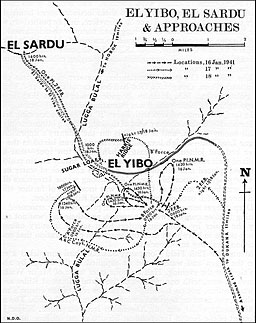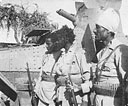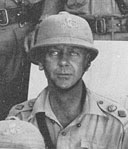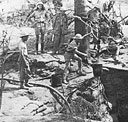
8
Capture of El Tibo
The task of 1st S.A. Division--less 1st S.A. Infantry Brigade Group, but with 25th East African Brigade under command--was the securing of the area Dukana-Hobok-Gebel Affur, so as to protect and develop communications to the north and to operate with flying columns in support of the Shifta rebellion in the general area Gardulla-Baco--in other words, in the Lake Chamo region north of Banno. To the west, the division was to capture Namaruputh and Todenyang and to plan to occupy Kalam, while co-operating with the Sudan Force's Equatorial Battalion.
On New Year's Day 1941, while 1st Transvaal Scottish was probing the Italian Somaliland frontier in the east, Captain C. A. C. Saunders, Second-in-Command of No. 2 S.A. Armoured Car Company, took a platoon of armoured cars forward to North Horr to work in collaboration with the Natal Mounted Rifles and the Abyssinian Irregulars, and following General Brink's conference with his Brigade Commanders the next day, the 2nd S.A. Infantry Brigade Intelligence Officer, Captain W. F. Steedman, together with Lieutenant Jack Bonham of the Irregulars, left by air in a JU 86 and dropped twelve cases of ammunition for the Shifta rebels who were on the escarpment in the Tertalli Hills west of Yavello, from which position they were co-operating with the Irregulars. Emissaries of the Shifta Chieftain, Haile Degaga, had come to see for themselves whether the South Africans meant business, and Robi, their leader, was impressed by the armoured cars. 'Kwaheru,' he saluted before departing, 'We shall meet again.'1
On the day that ammunition was being dropped for the Shifta, two armoured cars of No. 2 S.A. Armoured Car Company, supporting a patrol under Major Wocke of 1st Field Force Battalion, were fired on from Turbi Hills, but broke contact. Next day they attacked a Banda post and put the enemy to flight. The armoured cars then cleared the road for 6 miles north of Turbi with no further contact.2 The significance of this brush with outposts of their 21st Colonial Division could not have been lost on the Italians, for they appreciated that there were three possible lines of invasion from Kenya. The first and longest, with the best roads, was through Italian Somaliland; the most direct though more difficult route was through Moyale on to the motorable Neghelli-Dolo road and then via the Lakes to Addis Ababa. Finally, there was the extremely difficult route from Lake Rudolf northward, through





